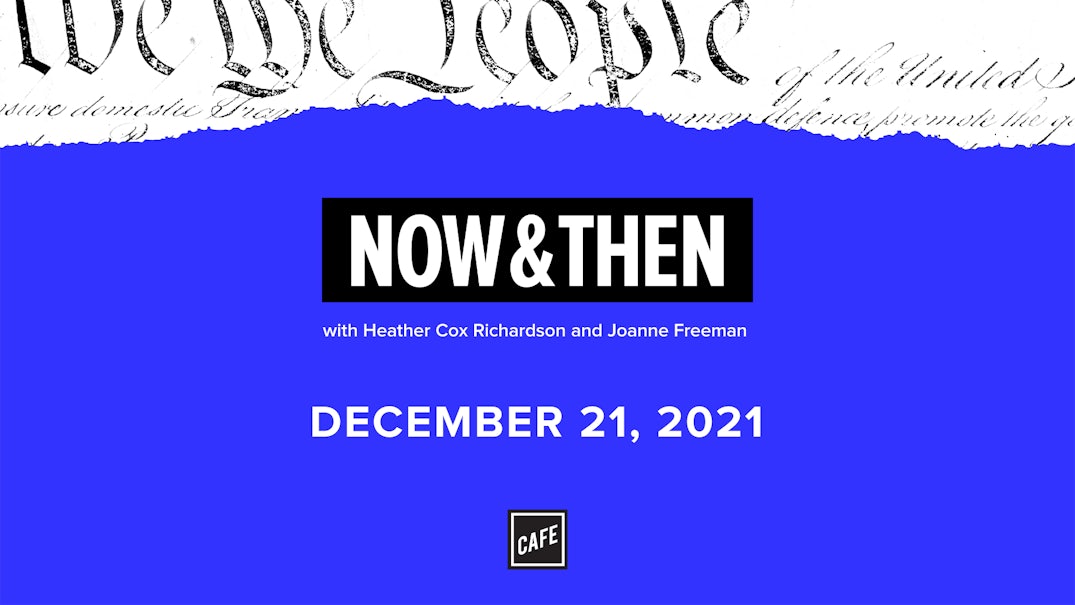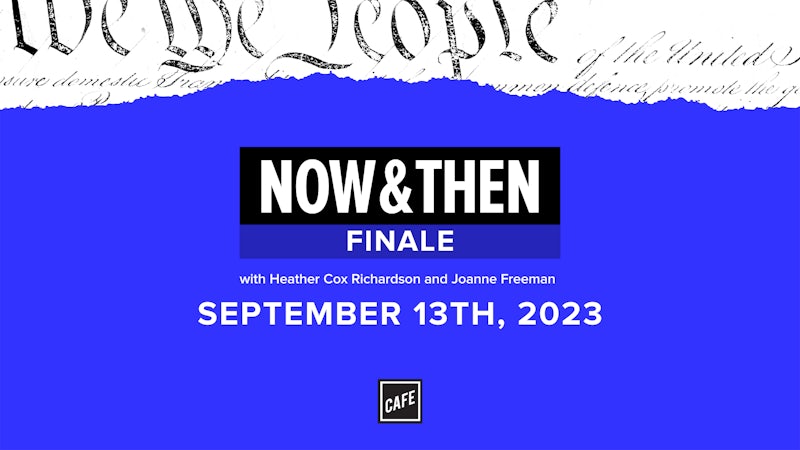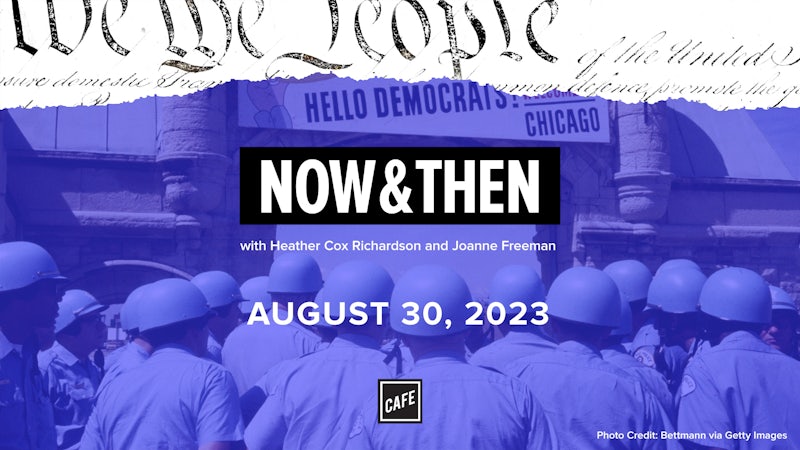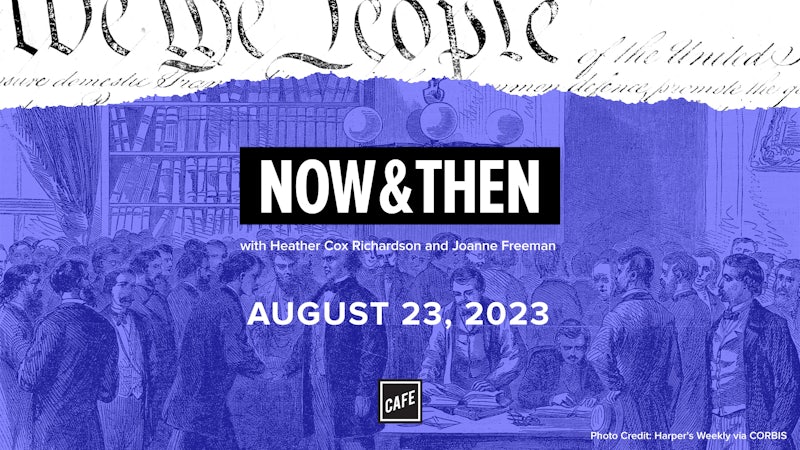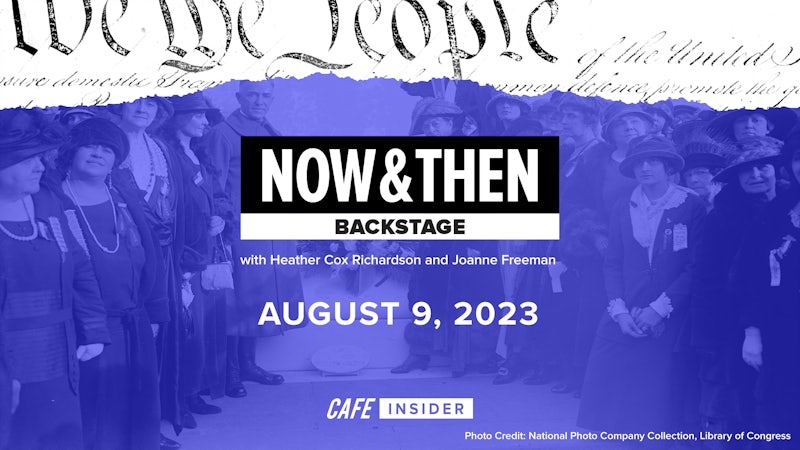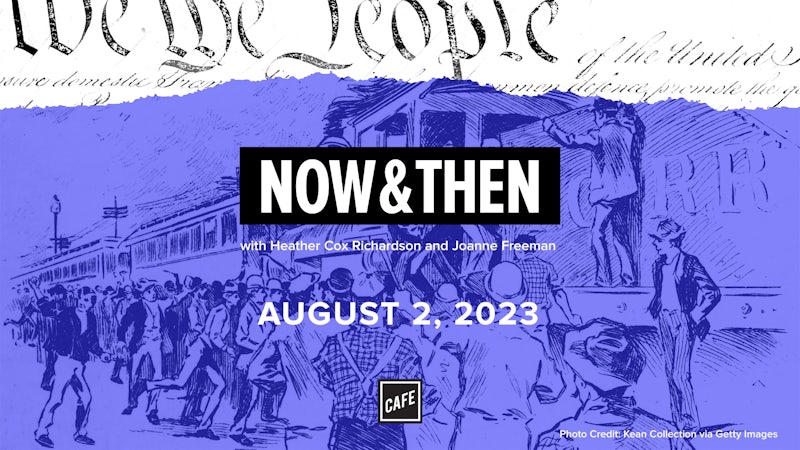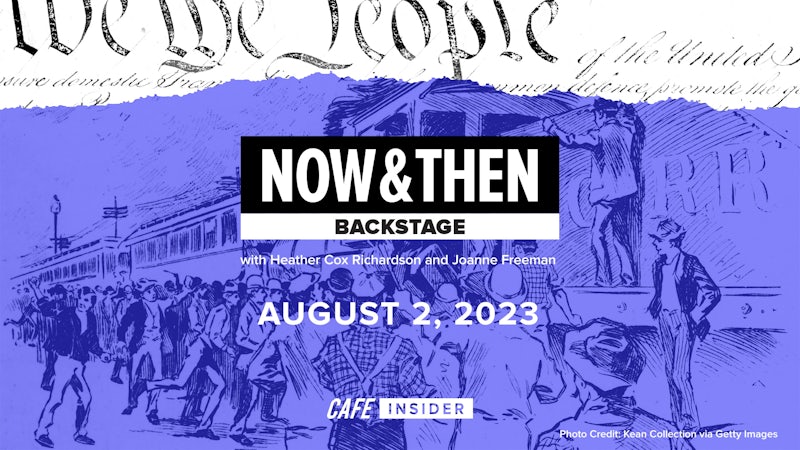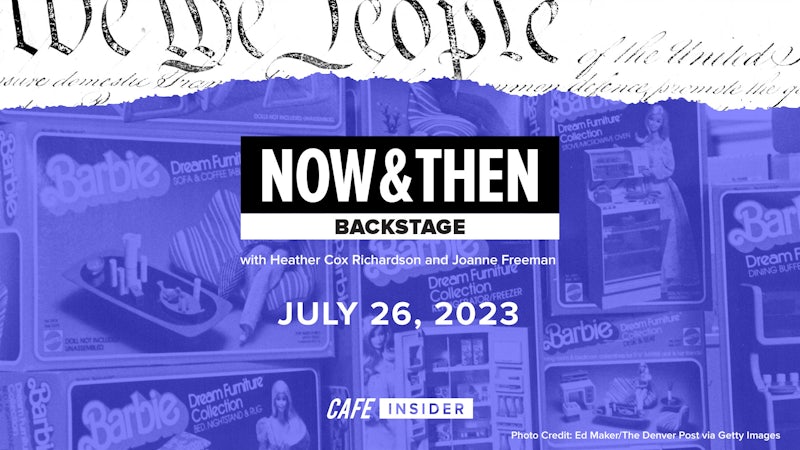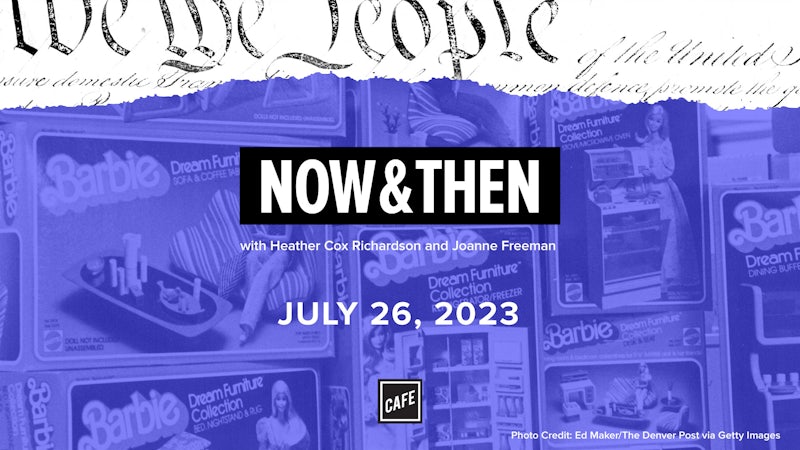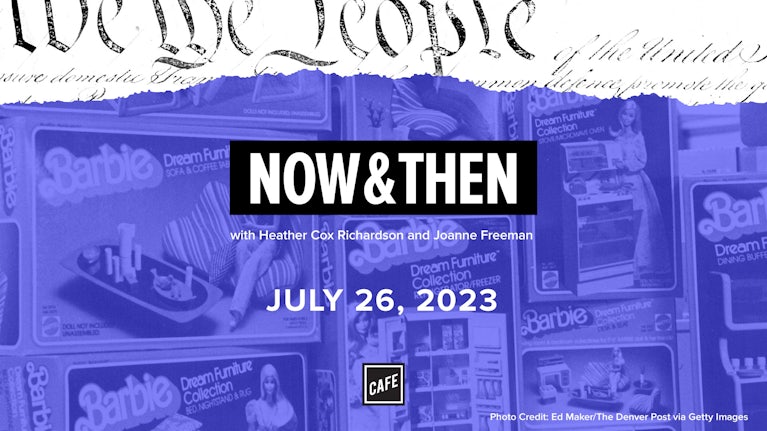Joanne Freeman:
Hey folks. As some of you know, each week Heather and I record a segment of Now & Then called Backstage, which is exclusively for members of CAFE Insider. Backstage gives us an opportunity to talk about the thought process behind our episodes, and to reflect on a slightly more personal level about our experiences as historians and public figures.
Heather Cox Richardson:
Given that this week marks our last Now & Then episode of 2021, we’re going to offer our Backstage segment for free. We talk about how we think about heroes and villains in history. To listen, head to cafe.com/backstage, and sign up to receive an email with the link to the episode. And if you already get emails from cafe, you need to sign up, you can expect one in your inbox.
Joanne Freeman:
Happy holidays, stay safe. And thank you as always for listening to Now & Then.
Heather Cox Richardson:
From CAFE and the Vox Media Podcast Network, this is Now and Then. I’m Heather Cox Richardson.
Joanne Freeman:
And I’m Joanne Freeman. This week, we’re approaching a topic that in some ways is a good end of the year topic. Because what we want to talk about is in a word heroes. And at this time of year, you sort of look back at the year, and you think about how it went, and who stood out, and who didn’t stand out. Time Magazine indeed does this every year by naming a person of the year, used to be man of the year. Although I guess the definition is according to Walter Isaacson, the former managing editor of Time Magazine, the person or persons who most affected and our lives for good or ill and embodied what was important about the year, for better or for worse. So that’s an important qualification that the person of the year doesn’t have to be a person we like.
However, regardless at this time of year, when we’re getting all of the top 10 lists, and this is the best, and this is the worst and whatever, seems like a good time for us, you and I Heather, to kind of muse about people who we consider in one way or another heroes. And we don’t necessarily agree on the definition here, which will be very cool to actually explore. But the starting point in a way, maybe this goes more towards ill than good, is the fact that Time Magazine’s person of the year this here is Elon Musk, one of the richest men in the world.
So immediately and not surprisingly, the selection of Musk caused controversy. And a lot of people instead suggested that capital police officer Eugene Goodman, who so famously misdirected the riots to protect members of Congress, that that’s the person who should be named person of the year.
Heather Cox Richardson:
And you’ll be shocked to hear that I’m team Goodman on this one and not team Musk. Because if you think about the repercussions of what Officer Goodman did that day, and what he stopped from happening that day, and where he placed himself on that day in between our democracy and those who would destroy it. In terms of the repercussions for what somebody has done their actions, to me that is far more significant than taking, what did he do? Take a rocket up to space and make a gazillion dollars.
Joanne Freeman:
He made a gazillion dollars.
Heather Cox Richardson:
So it does raise the question though of what is a hero. Because for me I saw that, I was like, really? And I get the whole idea of Time Magazine saying it doesn’t necessarily have to be somebody you like, it has to be somebody who’s important. So very famously in 1938, it had Adolf Hitler on the cover as the, it was the man of the year at the time. And the person of the year or the people of the year are often really significant. So in 1970, I talk a lot about the fact that the person of the year was middle America. The middle Americans, it’s a snapshot of a year. And I am not at all convinced that Elon Musk represents 2021.
Joanne Freeman:
Right. Even if it’s just a person who was important. How is he important? In what way is he important? So if 2021 is a year of really rich people doing things that fundamentally don’t matter a lot and yet get a lot of publicity, maybe that makes him the person of the year. I don’t know. I’m on team Goodman as well, particularly given that, and this is going to loop back to some of our conversation today about heroes. Particularly given that he did that in this spur of the moment. He saw a danger, he saw a crowd closing in. And in the spur of the moment, he came up with this plan to protect Congress from these people that were trying to attack it.
Heather Cox Richardson:
Which suggests it is who he is, not just, it is what he does. And to make that kind of a split decision. So that does bring up the question of what a hero actually is. And we’ve had this conversation before. Because as historians, you are observing of course what happened in the past. But there’s no doubt that you have a deeply informed impression of the way people are behaving.
Joanne Freeman:
Well, so here’s the interesting thing is when we first began having this discussion and you were quick to come up with a couple of names, and I had actually a hard time. And I even had to go away and take a day or two to think about it, and then come up with more names. I came up with one or two. I realized I don’t think that way. Certainly there are people that I admire, but I don’t think I’ve ever thought to myself who are my heroes in history. And I don’t fully know why that is. But when I was compelled to think about it, given that we’re having this discussion now, and I began picking people who stood out to me, what I realized was what they all had in common was the fact that they spoke out loudly, and persistently, and aggressively at times when speaking out was dangerous. So they gave voice to their beliefs or their principles. They stood for something. And they stood for that with themselves and their words in a way that mattered immensely at a time when what they stood for was under attack. So in one way or another, voicing beliefs while in danger somehow or other came to be a big chunk of my understanding of what a hero is.
Heather Cox Richardson:
The reason I even started thinking about heroes was because I wrote a book on the Wounded Knee Massacre, which was the hardest book I’ve ever written in the sense that I knew what was coming and I couldn’t stop it. And that is actually still a burden I carry. Every year about the time of the massacre is very hard time of year for me, because you’re so involved and you know it’s coming, and you can’t tell these people that they need to make a different decision.
Joanne Freeman:
Well, that’s the thing. That’s the thing, and this goes back to what you were just saying. That’s the thing is that if you’re studying these people, and writing about these people, and trying to figure them out, you feel that you know them in some way and there’s a personal dimension to this that it’s hard to move away from. And it’s the same thing in writing about the coming of the Civil War, right? You want to yell through time, my most recent book. You see what’s coming, you know that they can’t see what’s coming. That’s the very definition of historical contingency. And yet you have a sort of gut response because you’ve spent so much time with these people and the plight that they’re facing.
Heather Cox Richardson:
So somebody said to me, I actually had to take several months off of the writing of the book because I just couldn’t handle it. Somebody said, “There are human beings involved there. Are there any heroes in this?” I mean, it’s just a horrible story. Across the board, it’s horrible story. And I got thinking about that, because at first I was like no, this is horrible. And then I realized that I had two heroes in my mind. They don’t really show up as such in the book, but they were heroes because they did the right thing even when nobody was looking, and even as the walls were closing in. And weirdly, one was Sitting Bull, and the other was General George Crook, who was of course on the other side.
But as I thought about that after you and I talked, I thought, “I don’t think that definition, that you do the right thing when the walls are closing in is enough.” Because all the people I picked after we talked were something more than that. That is when I say they did the right thing, they were protecting people who were than them. So they weren’t just doing the right thing in an individual, moralistic way. They were putting themselves on the line to protect people. And curiously, all of the people I picked as we go through this are people who I would argue from a mythological standpoint are in liminal spaces. That is, they stand between two very powerful forces, and they put themselves in between those two very powerful forces to try and protect people weaker than them.
And I know that’s a really complicated definition of a hero, but all the people that jumped out from me and that we’ll talk about in this episode are people who are what I would consider in liminal space. That is in between two larger forces. And they are inserting themselves into that space or have come from that space and stayed in it. And are leveraging the power of their connections on both sides to try and protect people weaker than them. Although it sounds like that probably involves one and a half people in all of American history. I actually think that it covers a lot of the people that we’re talking about. People who are trying to stop, well, something like the Wounded Knee Massacre, and to stand in between two crushing forces and try and protect the people who can’t protect themselves.
Joanne Freeman:
I think that definition, even with the qualification that you didn’t necessarily have before, when I thought about mine, although they sound different, they’re actually very close to each other. Because in one way or another, I’m also talking about people who are risking themselves in a way that is important to them because of the implications to other groups, larger groups, often weaker groups, or groups that don’t have a voice. Or groups that don’t have a way to step forward and get the ear of the public in some way.
Heather Cox Richardson:
Okay. If that’s the case Joanne, who is the person that you want to start talking about?
Joanne Freeman:
The first person who came to mind for me is Ida B. Wells. Ida B. Wells, she’s amazing. She was actually born enslaved in 1862. She ends up being an investigative journalist, an educator, a really early leader in the civil rights movement. One of the founders of the National Association for the Advancement of Colored People, though she’s not often given that kind of credit. And in addition to doing all of these high pollutant things that are big accomplishments that when you have an obituary that get listed there, she was just in the fight with her person and her pin to make points about points that needed to be made like a major thing that she wrote about, lynching.
Heather Cox Richardson:
I’m a huge fan of Ida B. Wells as well. But the point that I have to throw in here is her parents died and she reared her siblings beginning from the time she was 16. So she’s doing all the stuff you’re talking about. She’s also taking care of a whole bunch of kids. She has to get a job teaching first. And then she becomes a journalist, and becomes not only a journalist as you say, but an activist.
Joanne Freeman:
So an early example of her putting her person and then her voice in the way of injustice and speaking out, not that because she’s the only person who this happens to, but because it happens to her and she could say something about it. She is traveling by train. This takes place in 1883, and she is sitting in a lady’s car on the train. And the conductor on that train asks her to move to a different car, basically because of her race. And she refuses to. And problems ensue, but I’m going to say this, I’m going to offer this in her words. She later described this incident.
She says, “When the train started and the conductor came along to collect tickets, he took my ticket, then handed it by, and told me that he couldn’t take my ticket there. I thought that if he didn’t want the ticket, I wouldn’t bother about it. So went on reading. In a little while when he finished taking tickets, he came back and told me I would have to go in the other car. I refused saying that the forward car was a smoker. And as I was in the lady’s car, I proposed to stay. He tried to drag me out of the seat. But the moment he caught hold of my arm, I fastened my teeth in the back of his hand.” So she just resisted. She ultimately is removed from the car, but she sues the rail company because of that incident. And initially wins that case, but it’s overturned and she ultimately loses it. But she’s fighting back with her person. And then after that incident, which many a person would respond to by feeling outraged, but also feeling mortified or too angry even to know what to do, she never stops. She just keeps going and pushes it to the point that she might be able to make a difference.
Heather Cox Richardson:
Well, so I love that story in part because you know 1883 is my favorite year in American history. And that is the year that the Supreme Court overturns the Civil Rights Act of 1874. So when she does that, she kind of underplays what she’s doing. She is I believe the first person in Tennessee to challenge the overturning of the Civil Rights Act. She is basically saying, “All right, let’s see how this baby plays out.” And when he drags her off the car, you just read that. She bites him.
Now, if you think about what that actually is like in the back of his hand where there’s not a lot of flesh, right? So there is no dirtier substance in the world basic than a human mouth. So for her to bite him in the day before antibiotics, this is like no, I’m dead serious. She could easily have killed him. And it was such a big, biting anybody in the 19th century was part of fighting and all that. But it was like she wasn’t carrying a weapon, a gun like all your people do. Well sorry. You know what I mean. But boy, she made it clear that you were not going to mess with her.
Joanne Freeman:
Right. And that gets us back to Goodman, right? It’s not like she sat there and thought, “What will be the thing I will do now?” She basically said, “No, you can’t do that. That’s not right. That’s not right.” And she fought with what she could fight with.
Heather Cox Richardson:
And she bit him. That’s something that I think that a lot of people don’t think about anymore is what that actually means because mouths are so dirty. Even now when somebody splits their knuckles on someone’s teeth, it’s called a fight bite. Right? And it can be really dangerous.
Joanne Freeman:
It is?
Heather Cox Richardson:
Yeah. How do I know that? And she does that, but she does it in service to the concept of civil rights. And she’s a small woman too. I mean, that’s the other piece. She’s not a big lady.
Joanne Freeman:
She goes on to do many, many things. She ends up doing a lot of research into lynching and writing a pamphlet titled Southern Horrors: Lynch Law in All Its Phases. She begins to publish that in 1892. And she examines a lot of accounts of lynching, supposedly due to the rape of white women and exposes that as a story being told and instead, concludes in writing that southerners cry rape as an excuse to hide their real reasons for lynchings, which on the one hand sometimes have to do with trying to shut down Black economic progress or Black businesses. And on the other hand has to do with protecting white southerners and in a sense defending white supremacy itself.
So she exposes that in a pamphlet, she writes a second pamphlet called A Red Record that discusses the same thing. And again, these are hugely influential. They’re widely republished. They have a big influence. Her pen, her voice, and speaking out on something that isn’t being spoken out about in that way before she comes along. She goes on and becomes very involved in not just civil rights, but women’s rights. She is upset initially because as someone who’s interested in women’s rights, many white women involved in women’s rights want that to be a white movement. And is sometimes ridiculed and ostracized by women’s suffrage organizations in the United States because she’s seen in a sense as an outsider in that cause. But she persists. That word has been in my mind since we began talking about her, yet she persisted. She continues going along and fighting for women’s rights. Later in her life in 1913, she and a group of black and white suffragist from Illinois traveled to Washington to join a women’s right to vote parade. And at the last minute, the organizers of the parade ruled that black suffragists would have to march in a separate unit so as not to offend Southern members of Congress. Thrilling.
She is outraged and refuses to march in a racially segregated parade. So when it begins, she bolts from the crowd of onlookers and joins the Illinois unit with two white supporters on either side of her. And she gets press recognition for what she did. The Chicago Broad Ax, what a name for a newspaper says that, “Mrs. Ida B. Wells-Barnett proudly marched with the head officials or with the head ladies of the Illinois delegation, showing that no color line existed in any part of the first national parade of the noble women who are in favor of equal suffrage.”
Joanne Freeman:
So her whole life, she’s standing up and with her voice and with her person, defending rights again and again, and again. I just find her amazingly admirable. So it doesn’t surprise me at all that when the thought went out, “Hey, maybe we could talk at the end of the year about heroes.” She’s the first person that came to mind.
Heather Cox Richardson:
For me, it’s always those men from the Wounded Knee Massacre. And in both cases as I say, they’re trying to protect people that are in between two giant objects smashing together. Sitting Bull is the leader of the Hunkpapa of the Lakota in the 1860s. And he takes over, he and Crazy Horse who had been part actually of the Oglala band, and Crazy Horse. When Red Cloud is the leader of the Oglala signs the Treaty of Fort Laramie in 1868. Crazy Horse goes further west and joins up with Sitting Bull. And Sitting Bull is really articulate about how this is my land. This is our land. Stop walking across it on your way to the gold fields of Montana. Stop trying to build forts here. This is our land.
Heather Cox Richardson:
And of course, he is up against the U.S. army and he does a number of things to try to pull the Lakotas, and the Cheyennes, and other group together to fight back against the army, but it doesn’t work. So we get the Battle of the Little Bighorn. And after the Battle of the Little Bighorn, he and his band crossed the line into Canada where they hope that they’re going to be able to take refuge from the U.S. Army. And he eventually has to come back with the band and settle on a reservation, the Standing Rock Reservation in what is now South Dakota.
And the reason that he became a hero for me is not because of the history I just outlined, but because what leads to the Wounded Knee Massacre is immovable objects if you will. The Benjamin Harrison administration in Washington is absolutely determined to keep control of the U.S. government even though the Republicans have begun to lose the popular vote by quite significant amounts. Harrison lost by 100,000 votes and he goes ahead and gets the election only because they fudge around in the electoral college. And what the Republicans do to try and shore up their power in the U.S. government, in the Senate primarily, but also in the electoral college is they add six new states to the union really quickly. And they’re expecting that they will be dominated by the Republicans.
But the problem with that is that, and this is going to happen. I mean, the way they write the legislation about for example dividing the Dakota territory into North and South Dakota, it says they’re going to be states. But the problem for everybody actually at that point is that South Dakota is essentially Lakota land. So the government has said, “Yeah, we’re going to have this state in a year, but now we got to get the Indians off it.”
The government sends one group of negotiators to try and buy the land. And the Lakota are like, “Nah, not happening. We’re good.” And they offered a terrible price and the Lakota needed the land. And then as the months tick by, the government sends a different commission known as the Crook Commission go out and get the signatures on this. The idea of a session of land across the middle of South Dakota.
And when they do that, of course it’s going to cause extraordinary havoc. And that havoc is going to eventually lead to the Wounded Knee Massacre. In the aftermath of the signatures that they get in 1889 to go ahead and get and let the government, the Lakota land, there is a religious movement amongst the Lakota in which they are trying to bring back the old world. It’s a peaceful movement, but it’s interpreted that very differently among the Indian agents who live out there. But Sitting Bull desperately wants to believe in this religion. It gives people visions of a past. It gives people of their dead who have died in an influenza epidemic the previous year. He desperately wants to be part of it. And he can’t. He is never able to go into one of the trances that the ghost dance brings. And yet when the U.S. army and the Indian agents keep trying to stamp out the ghost dance, he defends those people who are exercising this religion and saying, “Hey, we have the right to do this. This is our right to do this.” And he continues to try and protect his people in this terrible moment, even though he doesn’t think it’s real. He recognizes that principle that we talked about with James Madison, the right to conscience.
And he eventually of course dies for it. On December 15th, it’s a sort of complicated story, but he ends up getting killed because he refuses to give up the right to the ghost dance. And because he refuses to do what the army says. So that idea that he’s going to protect his people’s religion, even though he doesn’t believe it, because it’s the right thing to do. That’s why he became a hero.
And then on the other side, I said it was the Crook Commission that went ahead and forced the sale of the Indians to go ahead and agree to the sale of their land. And that sounds completely counterintuitive. Why would I say that’s a heroic thing to do? Well, Crook has a long history as a person who fought indigenous Americans, but he recognized I think that they were in real trouble, because American settlement was not going to stop. So rather than simply saying, “I’m just going to exterminate people on the one hand,” or on the other hand, “I’m going to go ahead and wash my hands of all this all together and walk away,” he tried to make it the best he could. In the sense that when the American government wanted to go ahead and take all this land, he really tried to get the best deal possible that he could for the Lakota. And he promised them all kinds of things. And he had the cloud in the government to go ahead and get them, get the things that he had promised for them.
And the indigenous people trusted him. They trusted that for example, he would get the ponies back that they had lost after the Battle of the Little Bighorn, and that they would be able to move around to different bands. He promised all of things to the Lakota in order to get them to sign away their lands, and went back to Washington to get those things, and fought very hard for them. And in the midst of the negotiations, General Crook dies of heart failure at Chicago’s Grand Pacific Hotel. And when that happens, another Lakota leader named cloud told a Catholic missionary, “Then General Crook came. He at least had never lied to us. His words gave the people hope. He died, their hope died again. Despair came again.”
In both of those cases, those are kind of weird people for me to say those jump out over Abraham Lincoln, although I’ve got my feelings about Abraham Lincoln and all that. But those are people who as I said, the walls were closing in for both of them. And they recognized the walls were closing in. And they tried to go ahead and pull out the best possible deal they could for people that they knew in many ways were doomed.
And that to me, it’s so much easier to walk away and to say, “I’m not going to get involved in this,” or, “I’m going to join the bad guys.” But to keep the skin in the game and say, “There’s going to be a lot of pain here for a lot of people. What could I possibly do to make this better and to try and turn the direction of history?” Just really jumped out for me about those two.
Joanne Freeman:
It’s an amazing story. And particularly the tribute at the end, the recognition of his sincerity in trying to fight for them.
Heather Cox Richardson:
Yeah. Yeah. So a funny one for me to put together over a massacre that I picked one general and one indigenous leader, but they’re the ones that got me starting to think about heroes. But I also have some [inaudible] heroes as well, whose lives turned out a little bit better. How about you? Who else do you want to throw into the mix?
Joanne Freeman:
I’ll throw someone into the mix who kind of walks the line between both of our definitions, puts themselves in a space where they’re needed in one way or another, and then speaks out in defense of himself and his people over the course of how it’s being portrayed. And that’s Richard Allen, who’s born enslaved in the colony of Delaware in 1760 and converts to Methodism when he’s 17 years old. Ultimately, buys his freedom and joins a mostly integrated congregation in Philadelphia, St. George’s Methodist Episcopal Church. And he becomes an assistant minister in the late 1780s. He leaves that church with fellow Black Reverend Absalom Jones, and they help found the Free African Society, which is a non-denominational religious mutual aids society that’s dedicated to helping the Black community. And ultimately he founds Bethel Church, which becomes known as Mother Bethel because it eventually gave birth to the African Methodist Episcopal church, and serves among other as a stop on the underground railroad.
So already without getting to the part that I’m going to mention, that’s a lot. That’s a lot to accomplish in a lifetime. But in 1793, there’s a huge yellow fever epidemic in Philadelphia. And roughly 10 to 20,000 of Philadelphia’s 50,000 residents fled. So a huge of people flee the city. By the time that the epidemic ended in November of 1793, so it’s just a couple months long, at least 5,000 people had died, which is about 10% of the population, perhaps even a little more.
So at the time of that epidemic, a very well-known doctor, one of my graduate professors used to call him doctor to the stars because he’s the fellow who is doctoring all of the sort of highfalutin high level founder folk named Benjamin Rush. He pleads with Allen and Jones to organize the Black community to care for the sick and dying who are afflicted with this yellow fever, with essentially this plague. Rush believed and a lot of other people did too, that they were immune from the sickness. And thus their assistance could be really important and wouldn’t put them at risk.
Now Rush was wrong about that theory, and roughly 240 Black Americans died of yellow fever. And most of them serving the community on the front lines of caregivers and as nurses. The part that brings Allen to mind for me is that towards the end of the epidemic, a publisher named Matthew Carey, who himself was no longer in the town, he had fled. He publishes an analysis of that plague titled A Short Account of the Malignant Fever. And in his account, Carey accuses the Black volunteers of, “Extorting high wages, or even stealing from those they nursed.” And he suggests that Black Philadelphians were guilty of spreading the disease.
Now Allen and Jones respond in early 1794 with their own statement, A narrative of the proceedings of the black people, during the late awful calamity in Philadelphia, these wonderful 18th century titles that go on forever. And the two men Jones and Allen meticulously refute all that carry charges with eyewitness testimony, with actual concrete evidence, while also chronicling all of the acts of mercy and generosity being performed by individuals, a lot of them within this work being named in full from the Black community.
They also speak out against the hypocrisy of the white community. So here’s a quote from Allen after describing all of these acts of charity and humanity from the Black community. “We do not recollect such acts of humanity from the poor white people in all the round we have been engaged in. We could mention many other instances of the like nature, but think it needless. It is unpleasant for us ache these remarks, but justice to our color demands it.” So he’s making a statement on behalf of people, not just himself, but on behalf of people who are being accused of something and have no voice to counter it.
He goes on to say in a memoir that’s actually published shortly after his death, that, “It was no small satisfaction into us what they did. For we think that when a physician was not attainable, we have been the instruments in the hands of God for saving the lives of some hundreds of our suffering fellow mortals.” Not only was he constantly over the course of his life standing up for his principles, creating and organizing institutions to help the Black community. But at this moment, after doing this work, stepping forward at a moment when it was dangerous to step forward, he then continued to voice and defend the Black community of Philadelphia against Carey coming up with these sort of nonsense charges. He held forth and made a statement publicly, aggressively in a way that’s admirable. So again, kind of like Ida B. Wells, he stood up and was a voice for people who needed that kind of a voice, and did it in a way that was both notable. And because it was exceptional, dangerous.
Heather Cox Richardson:
It is so interesting that you have picked writers.
Joanne Freeman:
I know. Well writers and as-
Heather Cox Richardson:
People getting their voices. Whereas my people talked, but they were more famous for negotiating I think. So I have a question for you, and we’ll get to more people. But the other thing about my people, both the other people that jumped to mind from me, which are Booker T. Washington and Fannie Lou Hamer. And Hector Garcia, Dr. Hector Garcia, all of whom were on my list is that all of them are what I would call twice born. And that is a concept that came from me from Robertson Davies’ book Fifth Business. Where he talks about once somebody has lost their life once, they have a very different approach to the days after that. And you see this with people who lived through traumatic experiences in war time. They’re like, “Well, I died once. You can’t kill me again.” So I can really put my life on the line again in a way that I couldn’t before that happened.
And that’s certainly true for Crook who was almost killed when he was in the Southwest. It’s certainly true for Sitting Bull whose stories of time in war were obviously life threatening. It’s certainly true of Fannie Lou Hamer, who was beaten almost to death by the police. It’s certainly true of Booker T Washington who began life as an enslaved man and was reborn after emancipation. And it’s certainly true of Dr. Hector Garcia, who was a soldier in World War II. And I wonder if maybe your people, I’m trying to think of your people. And true for Ida B. Wells, true for Richard Allen. Maybe not so much for somebody else on your list.
Joanne Freeman:
Right. So the other people who ended up on my list were Jane Swisshelm, who’s an abolitionist newspaper writer, journalist.
Heather Cox Richardson:
What is with you and writing?
Joanne Freeman:
Exactly. I know she wrote, but I wouldn’t say she falls into that category necessarily of twice born.
Heather Cox Richardson:
She’s running around in the 1850s then?
Joanne Freeman:
She’s running around indeed in the 1850s. Correct. She starts in 1848, a weekly newspaper that ultimately gets a big following in abolitionist circles. So you could say in that case, she’s finding her cause and lending her voice to it. She very deliberately does it as a woman knowing that that’s something unusual for a woman to do. And she writes a memoir. I have to read it because I just love the way that she voices this. Her newspaper is a single sheet with six columns, right? It’s a newspaper, but it’s a modest newspaper. And she says in her memoir the editors responded, “Like the world was falling. A woman had started a political paper. A woman. Press men were grabbing at their pants to save them from that woman.” At that point, she’s an abolitionist, but she very much becomes a woman abolitionist. And the thing that first brought her to my attention in my scholarship is she decides that she’s a reporter for The Tribune, she goes to Washington. And she decides, she realizes that no woman had yet been able to sit in the reporter’s gallery and report, that that had not happened yet. And she makes it her purpose to change that. And these are her words from her memoir.
“There was yet one innovation I wanted to make, although my stay in Washington would necessarily be short. No woman had ever had a place in the congressional reporter’s gallery. This door I wanted to open to them. Called on vice president [inaudible] and asked him to assign me a seat in the Senate gallery. He was very much surprised, tried to dissuade me. The place would be very unpleasant for a lady, would attract attention. I would not like it. But he gave me the seat. I occupied it one day, greatly to the surprise of the senates, the reporters, and others on the floor and in the galleries, but felt that the novelty would soon wear off and that women would work there and win bread without annoyance.”
The first day that she’s there by chance is a day that Henry Foote, Senator Henry Foote pulls a gun on Senator Thomas Hart Benton on the Senate floor. That’s her first day in the gallery there. And she writes an account of it and she’s an abolitionist. She makes it very clear that it’s a Southern slave holder’s upbringing that would lead them to do something like this in the Senate. And she’s of course torn apart as being a woman who is hysterical and is doing things that a woman would do in print. And that everything that she said should be dismissed as untrue and unimportant.
Heather Cox Richardson:
Hysterical unlike the guys on the floor of the Senate with the guns.
Joanne Freeman:
Exactly, exactly. Unlike the people aiming guns at each other on the Senate floor. But you’re right what you said, Heather. That she mostly looks for her cause, and then in a sense finds her way into who promoting another cause. But again, by my definition, I just love the fact that she’s really deliberately saying, “You know what? This needs to change, and I’m going to try and find a way to change it.”
Heather Cox Richardson:
I’m not going to go into the full biographies of the other three people that I had on my list, which were Booker T. Washington, Fannie Lou Hamer and Dr. Hector Garcia. I do feel like they need thumbnail sketches because they’re so incredibly important. And Booker T. Washington is another one that sometimes surprises people when I come up with it.
Booker T. Washington is born before the Civil War in 1856. He’s enslaved in Virginia for the first nine years of his life. And in 1865 of course with emancipation, he and his family move. They move to West Virginia. And when he’s nine years old, he goes to work packing salt. And then he goes to work in a coal mine. And from there, he’s going to be absolutely determined to get an education. And he goes ahead and he becomes first of all, sort of the right hand man to Samuel Armstrong at the Hampton Normal and Agricultural Institute in Virginia.
And from there, he goes ahead and starts Tuskegee College in Alabama. So he starts Tuskegee. And what interests me about Booker T. Washington, and Tuskegee is of course an attempt to go ahead and provide world class education for Black men in the wake of emancipation. But the reason that Booker T. Washington jumps out to me and he ends up getting a bad rap in a lot of history of the books, because he gives a speech in which he tries really to overwrite the growing sense that Black people don’t have a role in American society because they’re looking for a handout. When Booker T. Washington gave the Atlanta a compromised speech in 1895, what he’s really trying to do is get back to the immediate postwar concept in America that Black Americans simply should be allowed to as people said at the time run the race of life like anyone else.
So I actually think he was first of all, a brilliant man. I think that he is constantly trying to undercut the rowing white supremacy in under which he lives by using rhetoric, which of course interests me a lot. But he also interests me because he’s living it. While other people can make comments about what it’s like to live in America from relatively safe places in America, in Massachusetts for example, or overseas, he is literally in Alabama talking about Black people, being able to work and rise in American society the same as anybody else. And I think of Booker T. Washington. And I think of him going out of his door every morning and doing that every morning knowing that somebody could shoot him in the back at any moment. And that to me again, he’s putting himself literally in between the white people and the Black people in freaking Alabama in the worst part of reconstruction.
So he jumps out to me as a here row because how many of us would say, “This is great. I’ll just walk out of my door every day and try to protect people.” And how many people would choose that over saying, “You know what? I’m thinking Europe looks real good right now. Or I’m thinking I’m just going to move to some place”-
Joanne Freeman:
Go about my business and do my thing. And yeah, not stand up for anything.
Heather Cox Richardson:
And he makes enemies. He makes a lot of enemies because as I say, he’s in between these two spaces. And similarly of course, one of my great heroes is Fannie Lou Hamer. Because Fannie Lou Hamer is the youngest of 20 children. And she is the child of sharecroppers in Mississippi. And in 1961, she is given a hysterectomy without her consent by a white doctor, which sterilizes her of course, and goes on to adopt two of her own children. She becomes an organizer for trying to get people to vote in Mississippi. So she is one of the really driving forces behind what is going to become the terrific push in the middle of the 1960s to register voters in Mississippi.
And she is in 1963 arrested in Winona, Mississippi when she’s on a Greyhound bus coming from a voter registration drive in South Carolina. And when the bus arrives in Winona, she’s taken to the county jail and she is beaten almost to a death with loaded black jacks, very nearly killed. The white jailers forced two nearby black prisoners to beat her, and overheard as she was regaining consciousness one of the white officers proposed that they could actually take, “Them SOBs,” as they said, “And dump them in the river, and nobody would ever find them.” She ended up losing vision in one of her eyes and having permanent kidney damage from the attack. But it convinced her as I say that there was no reason for her not to continue to fight because they’d already killed her once. And she goes on to be really the voice of the Mississippi Freedom Democratic Party in 1964, which forced the Democratic Party really to begin grappling with the need to include Black Americans in the Democratic Party. And she goes to the Democratic National Convention to try and be included that year and is a really big force in Americans having to reckon with the idea of black voter participation.
And then similarly, Dr. Hector Garcia after World War II does something very similar for Hispanic Americans in Texas when he begins the American G.I. Forum really as a way for Hispanic veterans to begin to get equal treatment from the VA originally. But then he becomes a driving force behind the growing Hispanic movement in that era. And again, as a doctor and a veteran who was Spanish speaking, he stood in between the professional world, and the government, and the Hispanics, many of whom had been brought over on the Bracero program and treated not in any way in which the Bracero program was supposed to treat them. And he stepped up and said, “We’re going to put our lives on the line to make this better.” So all three of those people to me inserted themselves into this very hard place to try and smooth the way for people who are weaker than them.
Joanne Freeman:
What I like about all of these people, this assortment, is all of the different ways in which they stood up and did something that mattered. And these aren’t for the most part, some exceptions, but these aren’t initially really prominent people. They’re people who become prominent because of their actions, because of what they do, because of who they’re willing to be, because of where they put themselves. So one of the things about this episode is it’s telling stories of people who are heroes not because they’re famous. They are famous. Actually, they aren’t necessarily famous. They are heroes because of what they did, they should be famous. It’s part of why we’re talking about them today Heather is because they are all people who more people should know about if they don’t already know. But the assortment of people, the array of people, the different things they were fighting for, the ways in which they fought for them, the ways in which some were backed into what they were doing and that others found their way into what they were doing. And some could do something like ask a president to give them a seat. The congressional press gallery and others are writing pamphlets defending their own community from slanders out in the press.
And one way or another, all of these people in a way like Eugene Goodman, the Capitol Hill police officer who steers the crowd, deliberately steers them the wrong way, they’re finding a way to do something vitally important at a moment that it matters and deserved to be called heroes.
The last person I’ll throw in here just because he deserves to be mentioned, and he was one of the first people I thought of is the musician and folk singer, songwriter, and political activist Pete Segger. He’s just someone who threw out his life was using song to try and right wrongs. Initially, he helps form a group called The Almanac Singers, and they sing in favor of industrial unionization and racial and religious inclusion, and a variety of other causes. He helps create The Weavers after that. He’s a victim of the House Un-American Activities Committee. Again, sort of refuses to tell tales on anyone else and is blacklisted for a time. Ends up being a civil rights activist in the civil rights era. Any of you who’ve had the chance to see him in concert as I did once or twice, he uses song even in a sort of promotion of democracy, right? Sort of yelling out the lyrics so that everyone in the audience can say them back to him as a song proceeds through. I just admire him for the way in which as I just said a moment ago, he’s using a different medium, song, again in an activist kind of a way to pull people together, to move them to action. That’s also something that I always found admirable.
Heather Cox Richardson:
The final piece here for me is that this is exhausting work. The people we’re talking about put a lot of effort into this and were personally exhausted, but I also love that wonderful quotation from Fannie Lou Hamer about why she can’t stop. I mean, literally she has been beaten almost to death. And many people would say, “Okay, I’m out.” And she doesn’t. She keeps on pushing forward. And she says, “I’ve been tired so long, now I’m sick and tired of being sick and tired. And we want to change. We want to change in this society in America because you see we can no longer ignore the fact. And getting our children to sing oh say can you see by the dawn’s early light? What’s so proudly we hailed. What do we have to hail here? The truth is the only thing going to free us.” And I just love that idea that there comes a point when no matter how freaking tired you are, you just keep putting one foot in front of the other. And that maybe at the end of the day is the real definition of heroism.












